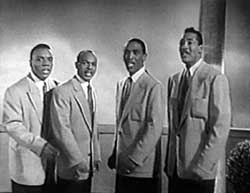 A simple straight-out live peformance, the Snader telescription Undecided (1951) shows the four Delta Rhytm Boys in loosely taylored suits just standing & facing the camera, the fifth at the piano off-camera for most of the film.
A simple straight-out live peformance, the Snader telescription Undecided (1951) shows the four Delta Rhytm Boys in loosely taylored suits just standing & facing the camera, the fifth at the piano off-camera for most of the film.
The four are singing the Sydney Robin & Charlie Shavers tune to a jazzy beat: "No matter what you've done, what you've done/ You've got me on the run, on the run/ Watcha gonna do, gonna do/ Tell me now, tell me now, tell me now/ First you say you do, then you don't/ Then you say you will, then you won't/ You're undecided now, so what are you gonna do."
I like the solo moments in this number better than the harmonizing, & am frequently struck by the fact that at least two of the Delta Rhythm Boys could've struck out on their own as complete solo acts. They had the physical beauty & the extreme vocal excellence to have individually become giants of the era. Unlike most harmonizing groups, they weren't reliant on the whole to be sensational, yet they didn't test it & remained together for a long career.
Still, I've liked other covers of this song better, though this is a solid little performance. It's just that sometimes the Delta Rhythm Boys bowl you over they're so good, but then they do one of these Mills Brothers wannabe numbers it's just curious they're not uniformly awesome & original.
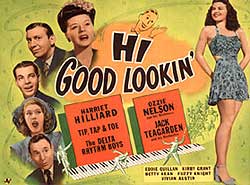 The Delta Rhythm Boys literally ran themselves as a corporation, & were practically a brand name. The business-end promoters in the boys' behalf pursued film appearances with a vengeance, & they had a particularly strong relationship with Universal Studios in the 1940s. The Delta Rhythm Boys literally ran themselves as a corporation, & were practically a brand name. The business-end promoters in the boys' behalf pursued film appearances with a vengeance, & they had a particularly strong relationship with Universal Studios in the 1940s.
Among the many feature-film appearances for The Delta Rhythm Boys was a guest-spot inHi, Good Lookin' (1944), a vehicle for Harriet Hilliard (Nelson) & Ozzie Nelson.
Ozzie & his orchestra with Harriet as his primary vocalist were big stars on radio, so this attempt to make them movie stars is set in a radio station.
The story is sweetness & light & not very consequential. Harriet is a midwest bumpkin who goes to Hollywood with a dream, & meets with almost no trouble achieving that dream. The emptyheaded plot provides a contextual structure for the music.
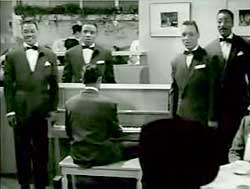 Kirby Grant sings for the Ozzie Nelson Orchestra on "I Won't Forget the Dawn" & Harriet joins Kirby on "By Mistake," "Slight Taste of Life," & "You're Just the Sweetest Thing." Harriet solos on "A Ship of Dreams." Ozzie himself campilly sings "Deacon Jones." Kirby Grant sings for the Ozzie Nelson Orchestra on "I Won't Forget the Dawn" & Harriet joins Kirby on "By Mistake," "Slight Taste of Life," & "You're Just the Sweetest Thing." Harriet solos on "A Ship of Dreams." Ozzie himself campilly sings "Deacon Jones."
Jack Teagarden with his own orchestra sings W. C. Handy's "Aunt Hagar's Blues." And Fuzzy Knight, best known as a comedy-relief sidekick in B-westerns, does "Buckwheat Cakes."
The Delta Rhythm Boys sing "Paper Doll," the Johnny S. Black composition that became one of the biggest hits of the decade -- when done by the Mills Brothers, whose influence the Delta Rhythm Boys never quite got out from under.
The rhythm boys have a gig in a busy restaurant, sweet tenor lead, & nearly acapella but for Rene DeKnight's slowly percussive piano beat. Lee Gaines' bass lead supplants Carl Jones' tenor halfway through, concluding with full harmony.
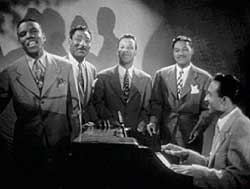 Another films that gave these guys a guest appearance was lighthearted musical comedy So's Your Uncle (1943). Another films that gave these guys a guest appearance was lighthearted musical comedy So's Your Uncle (1943).
It has its protagonist posing as his own aged uncle in order to avoid creditors, then as an "old" man he meets a rich old lady he hornswoggles into financing his "nephew's" stage review, in a morally bankrupt comedy scenario.
The music that keeps it from getting dull includes "That's the Way It Goes" & "Dark Eyes" sung by Mary O'Brien; the flapper era classic "You're Driving Me Crazy" sung by Jan Garber; & "Liza" sung by The Tailor Maids.
The Delta Rhythm Boys siningg "Don't Get Around Much Anymore" written by Duke Ellington & Bob Russell, & the W. C. Handy ultra-classic "St. Louis Blues" first made famous by Bessie Smith.
This version of "St. Louis Blues" isn't bluesy at all, but is a jump-jazz vocal arrangement to which you could easily do the boogie-woogie or jitterbug.
The cinematography for the number is dark & darker cast shadowym as though the lighting technician was familiar with the number but not with how the Delta Rhythm Boys would be performing it.
The lads are arrayed around the piano looking jolly & singing swell, smiling ear to ear. It's an emotional dissonance to hear those words that are making them so happy, a wonderful trick turning the blues inside out. Each of the four guys gets a solo moment or two.
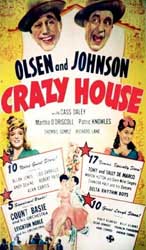 Sight-gag slapstick performers Ole Olsen & Chic Johnson, playing themselves, have decided they're going to film a musical, resulting in the cornpone comedy of Crazy House 1943.
Sight-gag slapstick performers Ole Olsen & Chic Johnson, playing themselves, have decided they're going to film a musical, resulting in the cornpone comedy of Crazy House 1943.
Olsen & Johnson made awful leads, as their vaudeville stage acts were simply too old-hat to be worthy of resurrection. The basis of their comedy was mutual injuries & destruction of property.
What manages to make it mostly worth watching is the fabulous array of guest stars, including Basil Rathbone & Nigel Bruce promoting themselves as Holmes & Watson, Tony & Sally DeMarco performing the jitterbug & lindy hop, & bits from novelty performers such as the talented obese dancer Tiny Bunch.
There are many cameo appearances of just everyone who was at the Universal studio lot the week it must've taken to make this thing, & though they have nothing much to do in the film, it's fun to watch for all the cameos.
And then there are the guest appearances by Count Basie who throws the block party attended by Martha Tilton, The Glenn Miller Singers including Marion Hutton, & The Delta Rhythm Boys, the latter singing "Pocketful of Pennies" & "Wrap Your Troubles Up In Dreams," much in the style of the Inkspots. As a bonus they perform a comedy song, "Rigoletto Blues."
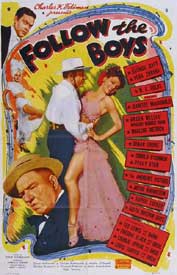 Follow the Boys (1944) is truly crowded with entertainment, as it was designed to lift American morale during the war, the government having elicited Hollywood's assistance in the war effort.
Follow the Boys (1944) is truly crowded with entertainment, as it was designed to lift American morale during the war, the government having elicited Hollywood's assistance in the war effort.
When released to theaters everyone who went to see it was well informed they were being treated to the same entertainers who really had visited American military bases around the world. And everyone would also know that "follow the boys" was interchangeable with "Uncle Sam wants you."
The first fourth of the film is about the rising career of vaudevillian Tony West (George Raft) trying to make a transition to a Hollywood career, meeting & falling in love with Gloria Vance (Vera Zorina).
Then Pearl Harbor is attacked, & Tony is eager to join the army. He's rejected because of a knee injury & is at first deeply stricken that he's of no use to the war effort -- until he lights on the idea of "let's put on a show for the troops!" & joins the USO.
Dinah Shore sings "I'll Walk Alone" & "I'll Get By." Louis Jordan & His Tympany Five perform their great hit "Is You Is or Is You Ain't My Baby" as well as "Sweet Georgia Brown" (with George Raft dancing to the latter.
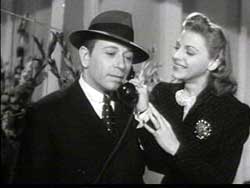 George Raft joins Vera Zorina for a duet of "Tonight" written by Walter Donaldson. Verna sings "I Feel a Song Coming On" with George in the back-up harmony group. Arthur Rubinstein is at the piano when Vera sings "A Better Day is Coming." George Raft joins Vera Zorina for a duet of "Tonight" written by Walter Donaldson. Verna sings "I Feel a Song Coming On" with George in the back-up harmony group. Arthur Rubinstein is at the piano when Vera sings "A Better Day is Coming."
The Andrew Sisters do "Shoo Shoo Boogie" plus a manic medley of their hits. Sophie Tucker sings "The Bigger the Army, The Better the Lovin' Will Be."
The Charlie Spivak Orchestra does "Swing Low, Sweet Chariot" & provide the instrumentation for the Donald O'Connor & Peggy Ryan duet "Kitten With My Mittens Laced." Jeannette MacDonald does "I'll See You in My Dreams" while visiting hospitalized soldiers.
There's quite a bit more, including flemenco dancer Carmen Amaya, & the Delta Rhytm Boys, who do "The House I Live In" written by Earl Robinson & Lewis Allan.
There was so much music crammed into Follow the Boys that the only way there'd be room elft over for a plot was to make the film butt-achingly long, pushing two hours.
Besides the cast for the fictional drama, there's a large array of cameos for big stars playing themselves. Orson Welles does a magic act assisted by Marlene Deitrich, which is one of the film's authentic highlights. W. C. Fields shoots clever pool. Other playing-themselves guests included Louise Beavers, Noah Berry, Lon Chaney, Jr., & Andy Devine.
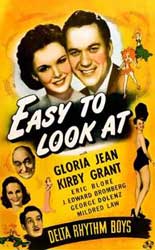 The Delta Rhythm Boys again sing "Is You Is or Is You Aint My Baby" in Easy to Look At (1945). This was a trivial one-hour Gloria Jean vehicle bolstered by the musical numbers.
The Delta Rhythm Boys again sing "Is You Is or Is You Aint My Baby" in Easy to Look At (1945). This was a trivial one-hour Gloria Jean vehicle bolstered by the musical numbers.
The project handed over to one of the worst directors on the lot, Ford Beebe, who usually made B westerns & B jungle flicks suited mainly for kids.
A small-town girl heads to Manhattan where she wants to become the next big costume designer, & never mind she's also a singer. Alas, she is soon embroiled in a false accusation of having stolen a pattern. The romantic lead (Kirby Grant) saves the day.
There'll be a half-dozen musical numbers along the way, none to equal the Delta Rhythm boys insertion.
Universal Studios was giving Gloria Jean a shot at being a star in a series of B-pictures that weren't written well, but were bolstered by guest appearances that would presumedly bring in the crowds even if no one cared about the leading lady.
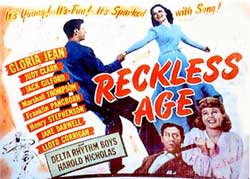 In Reckless Age (1944) she plays a young woman who comes from wealth but doesn't want to rely on her family. In Reckless Age (1944) she plays a young woman who comes from wealth but doesn't want to rely on her family.
She takes on a new identity & sets out to prove she can make it on her own, getting a sales job in one of her grandfather's chain of department stores without anyone knowing her family owned everything, & moving into a boarding house where she gets to meet "real" people.
Gloria had great potential but in those days without agents to look out for a starlet, most of the almost-weres never got very far before a studio gave up on them, even when it was the studio's fault. The Catch-22 was Gloria Jean had to go over big with the public, then get cast in films more people might go see.
As it stands, the only reason to feret out this film is for the guest stars. You'll be treated to Harold Nicholas providing a fabulous tapdance routine, & the Delta Rhythm Boys yet again singing the Louis Jordan classic "Is You Is Or Is You Ain't My Baby."
Gloria Jean herself starts singing a couple of songs but always gets interupted, very curious since the film was supposed to help launch her to bigger things. It appears nobody involved with the project was supporting her. So the highlight is definitely in the guest-spots of tapdancer & harmony group.
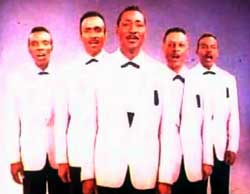 The Delta Rhythm Boys made made two 16 mm visual jukebox Scopitone films in France, where the Scopitone fad was much more extensive than in the US, though not much more longlived. The Delta Rhythm Boys made made two 16 mm visual jukebox Scopitone films in France, where the Scopitone fad was much more extensive than in the US, though not much more longlived.
The boys had moved to Europe in 1956 & drew large crowds in several nations, at a time when a combination of America's spirit-crushing racism & the commercial collapse of all other forms of music in the face of rock & roll made it easy to just leave & go somewhere where R&B was increasingly valued.
In 1958, after a a nine month engagement at the Moulin Rouge, they were as well known in France as in America. So when the Scopitone fad began in 1961, they were a natural choice for the French visual jukeboxes.
When they made the scopitone films, Kelsey Pharr was dead & Carl Jones had retired. In their stead were Herb Coleman & Hugh Bryant. So they weren't quite the same group they were in the 1940s, at their height. (They'd still be performing in the 1970s, with the final line-up replacing first & second tenor with Walter Tramell & Ray Beauty.)
They filmed So High, So Wide, So Low (1961) & Come Softly To Me (1961). For the latter, Lee Gaines is standing center-screen alone in the first few seconds, his deep bass "doo-doo-doo-doos" starting it off, & it's immediately obvious we're much more strongly in doo-wop territory than ever before with the Delta Rhythm Boys.
This song was a giant hit for The Fleetwoods at the tail-end of the doo-wop craze in 1959. With its nearly-acapella, it was a natural for The Delta Rhythm Boys to cover. It's intriguing that the rise of doo-wop so influenced the style of the Delta Rhythm Boys. They're no longer just 1940s "precursors" to doo-wop but have updated their sound entirely, these guys proving themselves as versatile as ever.
copyright © by Paghat the Ratgirl
|
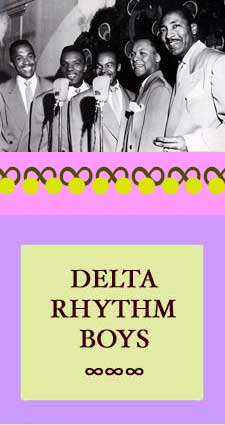


 Kirby Grant sings for the Ozzie Nelson Orchestra on "I Won't Forget the Dawn" & Harriet joins Kirby on "By Mistake," "Slight Taste of Life," & "You're Just the Sweetest Thing." Harriet solos on "A Ship of Dreams." Ozzie himself campilly sings "Deacon Jones."
Kirby Grant sings for the Ozzie Nelson Orchestra on "I Won't Forget the Dawn" & Harriet joins Kirby on "By Mistake," "Slight Taste of Life," & "You're Just the Sweetest Thing." Harriet solos on "A Ship of Dreams." Ozzie himself campilly sings "Deacon Jones."


 George Raft joins Vera Zorina for a duet of "Tonight" written by Walter Donaldson. Verna sings "I Feel a Song Coming On" with George in the back-up harmony group. Arthur Rubinstein is at the piano when Vera sings "A Better Day is Coming."
George Raft joins Vera Zorina for a duet of "Tonight" written by Walter Donaldson. Verna sings "I Feel a Song Coming On" with George in the back-up harmony group. Arthur Rubinstein is at the piano when Vera sings "A Better Day is Coming."
 In Reckless Age (1944) she plays a young woman who comes from wealth but doesn't want to rely on her family.
In Reckless Age (1944) she plays a young woman who comes from wealth but doesn't want to rely on her family.